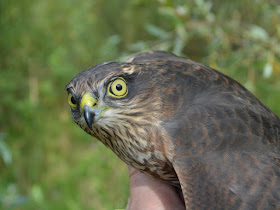Today's total of 12 ringed is the 2nd highest day total for the site and has only been bettered twice; on 14/08/14 and 17/08/15 with 13 ringed on both of those dates. Half of today's Tree Pipits were adults which is quite unusual but it gave me an opportunity to photograph some of the plumage features used when ageing birds in autumn. More information on ageing Tree Pipits can be found here, here and here (the latter being the best in my opinion) They are fairly straightforward to age once you get your eye in and fully understand their moult, especially if you get to handle quite a few, but I would say they are not as easy to age as Meadow Pipits.
 |
| S881401 Adult (2cy+) Tree Pipit. Adults have fresher and more olive-buff fringed median and greater coverts. |
 |
| S881401 2cy+ Tree Pipit. This adult was interesting in that it hadn't replaced 2 lesser coverts which stand out as being very worn and bleached. |
 |
| S881408 1cy Tree Pipit tail |
 |
| S881410 2cy+ Tree Pipit tail. |
 |
| S881410 2cy+ Tree Pipit wing. |
Ringing totals for 20/08/17 were: Sparrowhawk 1; Goldcrest 3; Blue Tit 9; Chiffchaff 6; Willow Warbler 15 (1); Blackcap 1; Whitethroat 2; Treecreeper 1; Wren 1; Tree Pipit 5; Chaffinch 1; Linnet 2; Goldfinch 2.
Ringing totals for 21/08/17 were: Chiffchaff 2 (1); Willow Warbler 6 (1); Whitethroat 1; Nuthatch 1; Tree Pipit 12; Chaffinch 4; Bullfinch 2.
 |
| Juvenile male Sparrowhawk 20/08/17 |
 |
| Juvenile male Sparrowhawk 20/08/17 |
 |
| Nuthatch 21/08/17 |





No comments:
Post a Comment